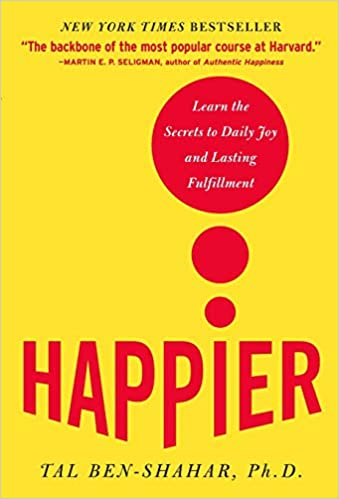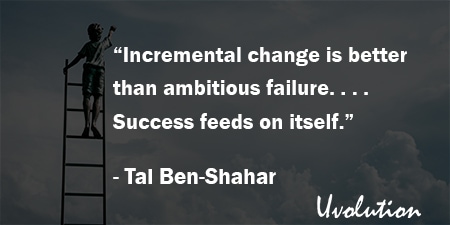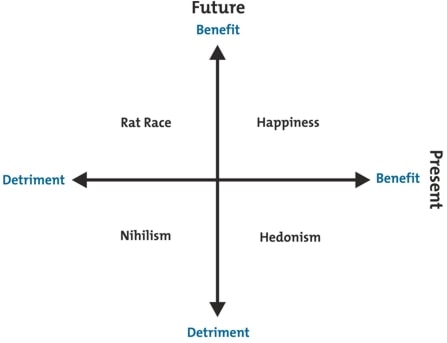Happier by Tal Ben-Shahar
The Book in 1 Sentences
Happier: Learn the Secrets to Daily Joy and Lasting Fulfillment
“I define happiness as ‘the overall experience of pleasure and meaning.’ A happy person enjoys positive emotions while perceiving her life as purposeful. The definition does not pertain to a single moment but to a generalized aggregate of one’s experiences: a person can endure emotional pain at times and still be happy overall.” ~ Tal Ben-Shahar
5 BIG Ideas
1. Attaining lasting happiness requires that we enjoy the journey on our way toward a destination we deem valuable.
2. What rituals would make you happier? What would you like to introduce to your life?
3. Each night before going to sleep, write down at least five things that made or make you happy—things for which you are grateful.
4. “Whatever you can do or dream you can, begin it. Boldness has genius, power and magic in it. Begin it now!”
5. Comfort, Stretch & Panic Zones
Happier Book Summary
1. The 4 Archetypes
“The rat racer’s illusion is that reaching some future destination will bring him lasting happiness; he does not recognize the significance of the journey.
The hedonist’s illusion is that only the journey is important.
nihilist, having given up on both the destination and the journey, is disillusioned with life.
The rat racer becomes a slave to the future; the hedonist, a slave to the moment; the nihilist, a slave to the past.
Attaining lasting happiness requires that we enjoy the journey on our way toward a destination we deem valuable.
Happiness is not about making it to the peak of the mountain nor is it about climbing aimlessly around the mountain; happiness is the experience of climbing toward the peak.”
2. The REAL Ultimate Currency
“A human being, like a business, makes profits and suffers losses. For a human being, however, the ultimate currency is not money, nor is it any external measure, such as fame, fortune, or power. The ultimate currency for a human being is happiness.”
“Money—beyond the bare minimum necessary for food and shelter (and I am not talking caviar and castles)—is nothing more than a means to an end. Yet so often we confuse means with ends and sacrifice happiness (end) for money (means).”
“In 1968, college freshmen were asked what their personal goals were: 41 percent wanted to make a lot of money, and 83 percent wanted to develop a meaningful philosophy of life.
The pattern was significantly different in 1997, when 75 percent of freshmen said their goal was to be very well off financially, and 41 percent wanted to develop a meaningful philosophy of life.
As larger numbers of people come to perceive material wealth as an end in itself, and, thus, as more individual members of society are unhappy, society as a whole nears a state of emotional bankruptcy.”
“Happiness is not just a luxury, something to be pursued once all our personal and societal ills are resolved. Increasing the levels of the ultimate currency improves the quality of individual lives and can make the world a better, safer place.”
3. Happiness Rituals and Habits
“For athletes, being a top performer is a deeply held value, and therefore they create rituals around training; for most people, hygiene is a deeply held value, and therefore they create the ritual of brushing their teeth. If we hold our personal happiness as a value and want to become happier, then we need to form rituals around that, too.”
“The most creative individuals–whether artists, businesspeople, or parents– have rituals that they follow. Paradoxically, the routine frees them up to be creative and spontaneous.”
So, think about that: “What rituals would make you happier? What would you like to introduce to your life?
It could be working out three times a week, meditating for fifteen minutes every morning, watching two movies a month, going on a date with your spouse on Tuesdays, pleasure reading for an hour every other day, and so on.
Introduce no more than one or two rituals at a time, and make sure they become habits before you introduce new ones. As Tony Schwartz says, ‘Incremental change is better than ambitious failure. …Success feeds on itself.’”
4. Negative Rituals
“Change, especially of deeply ingrained habits and patterns, does not happen overnight. Most important, once again, is to ritualize your activities. In addition to creating a habit of activities that you want to engage in, introduce negative rituals—times during which you refrain from doing certain things.
For example, if feasible, create an Internet-free time zone, each day between certain hours. We spend an increasing amount of time on the Web; checking our e-mail every few minutes takes away from our productivity and creativity and ultimately makes us less happy.
You can also introduce phone-free or meetings-free time zones, when you can fully focus on other activities, whether getting work done or spending time with your friends.”
5. Daily Gratitude Journal
“In research done by Robert Emmons and Michael McCullough, those who kept a daily gratitude journal—writing down at least five things for which they were grateful—enjoyed higher levels of emotional and physical well-being.
Each night before going to sleep, write down at least five things that made or make you happy—things for which you are grateful. These can be little or big: from a meal that you enjoyed to a meaningful conversation you had with a friend, from a project at work to God.”
6. Lifelines Vs Deadlines!
“My wife, Tami, and I often help each other set goals for ourselves—personal as well as joint ones. A few years ago, as I was talking about setting a deadline for one of the goals, she pointed out to me that because self-concordant goals inspire—literally, can put the spirit in us—it would be more appropriate to speak of lifelines. Similarly, when in pursuit of goals that are both pleasurable and meaningful, that yield both present and future benefit, we are enlivening time rather than killing time.”
“To experience a sense of purpose, the goals we set for ourselves need to be intrinsically meaningful.”
“The psychologist Abraham Maslow once wrote that ‘the most beautiful fate, the most wonderful good fortune that can happen to any human being, is to be paid for doing that which he passionately loves to do.’”
7. Make a Commitment
“In 1879 Thomas Edison announced that he would publicly display the electric lightbulb by December 31, even though all his experiments had, to that point, failed. He threw his knapsack over the brick wall—the numerous challenges that he still faced—and on the last day of that year, there was light.
In 1962, when John F. Kennedy declared to the world that the United States was going to land a man on the moon by the end of the decade, some of the metals necessary for the journey had not yet been invented, and the technology required for completing the journey was not available. But he threw his—and NASA’s—knapsack over the brick wall. Though making a verbal commitment, no matter how bold and how inspiring, does not ensure that we reach our destination, it does enhance the likelihood of success.”
Tal Ben-Shahar quotes W.H. Murray’s thoughts on the matter from his Scottish Himalaya Expedition: “Until one is committed, there is hesitancy, the chance to draw back, always ineffectiveness concerning all acts of initiative and creation.
There is one elementary truth, the ignorance of which kills countless ideas and splendid plans; that the moment one definitely commits oneself, then providence moves too.
All sorts of things occur to help one that would never otherwise have occurred. A whole stream of events issues from the decision raising in one’s favor all manner of unforeseen events, meetings and material assistance which no one could have dreamed would have come their way.
I have learned a deep respect for one of Goethe’s couplets: ‘Whatever you can do or dream you can, begin it. Boldness has genius, power and magic in it. Begin it now!’”
8. Comfort, Stretch & Panic Zones
“…they were encouraged to take risks and find their stretch zone (the healthy median between their comfort and panic zones).”
Mihaly Csikszentmihalyi says in his great book Flow: “In all the activities people in our study reported engaging in, enjoyment comes at a very specific point: whenever the opportunities for action perceived by the individual are equal to his or her capabilities.
Playing tennis, for instance, is not enjoyable if the two opponents are mismatched. The less skilled player will feel anxious, and the better player will feel bored. The same is true for every other activity… Enjoyment appears at the boundary between boredom and anxiety, when the challenges are just balanced with the person’s capacity to act.”
“The most successful people are lifelong learners; they constantly ask questions and never cease to explore the wonder-filled world around them. Regardless of where you are in life—whether you are fifteen or a hundred and fifteen, whether you are going through a rough patch or are thriving—create an education program for yourself.”
9. Time Affluence Vs Material Affluence
“Psychologist Tim Kasser shows in his research that time affluence is a consistent predictor of well-being, whereas material affluence is not.
Time affluence is the feeling that one has sufficient time to pursue activities that are personally meaningful, to reflect, to engage in leisure.
Time poverty is the feeling that one is constantly stressed, rushed, overworked, behind. All we need to do is look around us—and often within ourselves—to realize the pervasiveness of time poverty in our culture.”
10. The Time Machine Exercise
“You are one hundred and ten years old. A time machine has just been invented, and you are selected as one of the first people to use it. The inventor, a scientist from NASA, tells you that you will be transported back to the day when, as it happens, you first read Happier.
You, with the wisdom of having lived and experienced life, have fifteen minutes to spend with your younger and less experienced self. What do you say when you meet? What advice do you give yourself?”
That was my QUICK Happier book summary. If you’re interested, get your copy. There is a HUGE amount of wisdom and life-changing ideas in this book, and we’ve only touched on a tiny bit of it.
Buy The Book: Happier by Tal Ben-Shahar

GET Blinkist 7 Days FREE Trial
3000+ Book Summaries
(Audio and Text)






